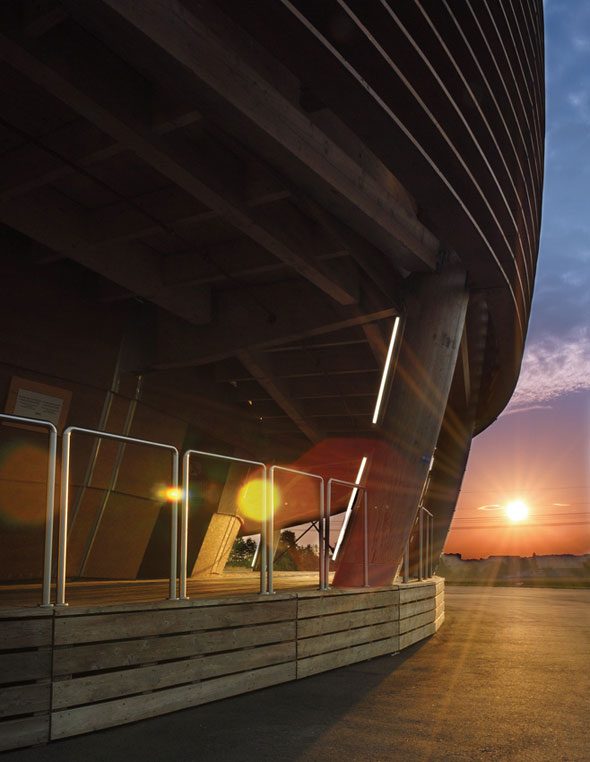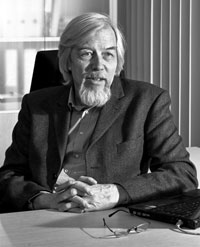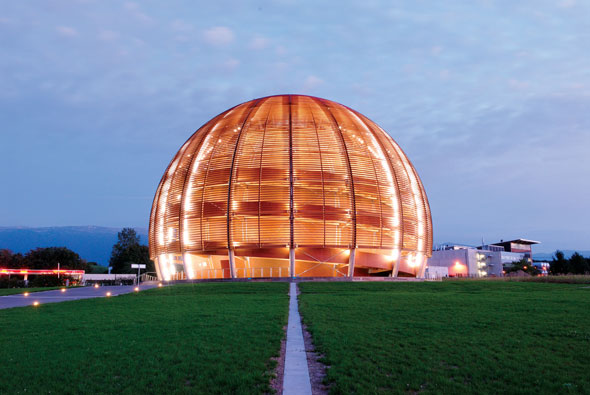A new leader for CERN
In his first few months on the job, CERN Director-General Rolf-Dieter Heuer opens new lines of communication, oversees repairs to the Large Hadron Collider, and promotes a worldwide strategy for particle physics based on a strong mix of global, regional, and national projects.
By Katie Yurkewicz
 |
|
| Photos: CERN | |
 |
On January 1, German particle physicist Rolf-Dieter Heuer began a five-year term as the director-general of CERN, the European Organization for Nuclear Research. Heuer takes the helm at a singularly challenging time for the European particle physics laboratory. He faces the immediate tasks of repairing and restarting the Large Hadron Collider and rebuilding the laboratorys aging infrastructure, all in the framework of a worldwide financial crisis. He is also likely to guide the laboratory through the years in which a decision will be made on the next big particle physics project after the LHC. Alongside all of this, he hopes to advance an ambitious agenda to reshape the future of particle physics researchnot just at CERN, but worldwide.
Heuer is not a stranger to CERN or to the complexities of the international particle physics community. He was on the staff of the laboratory for 14 years, ascending to the post of spokesperson for the OPAL experiment at CERNs Large Electron-Positron collider. In 1998 he left CERN for the University of Hamburg, and in 2004 became research director for particle physics and particle astrophysics at the German laboratory DESY. There he shaped DESYsand the countrysrole in global particle physics, in the process setting the stage for many of the ideas he is now pushing forward at CERN in the areas of communication, cooperation, expansion, and innovation.
Breaking news
When asked to name the biggest change he has introduced in his first months at CERN, Heuer immediately identifies his policy of clear and fast communication to CERNs staff and the users of its experimental facilities. Within weeks of his arrival, CERNs weekly bulletin began to publish LHC repair updates, and Heuers office began emailing major news to staffeven late on Friday evenings, when needed. Following in the footsteps of many a chief executive, Heuer has also remarked on his hope of reducing the distance between the CERN management and staff as much as possible, by showing his presence around the laboratory.
Clear and open communication with governments, laboratories, and institutes around the world is also critical for a laboratory that is funded and run by 20 member countries, has agreements with more than 40 others, and counts 111 nationalities among its staff and users. To provide a conduit for such communication, and to strengthen the laboratorys relationship with other particle physics institutes, Heuer established a new External Relations unit at CERN. This unit will also play a key role in Heuers bolder, and potentially more controversial, ideas for the future of the laboratory.
A broad vision
Heuers vision for CERN is to reshape it from a European laboratory toward a truly global laboratory, building on a trend that started long before his appointment.
The experiments at the Large Hadron Collider, soon to become the worlds highest-energy particle accelerator, now boast more than 7000 scientist collaboratorsroughly half the worlds particle physicists. In 2006 the CERN Council, the laboratorys governing body, took on the responsibility of leading European particle physics strategy. And in December 2008 the Council approved the creation of a study group to examine the geographical and scientific enlargement of CERN.
Heuer is quick to note that the laboratory wont be making any radical changes in scientific direction. CERNs raison detre is accelerator-based particle physics, he explains. This is the strength of CERN, and this is where we have world experts. I see scientific enlargement, in a very careful way, mainly in the direction of particle astrophysics. A field at the intersection of particle physics, astronomy, and cosmology, particle astrophysics is the study of elementary particles that originate in space, and would be the most natural extension for CERN.
Expansion plans
A major particle astrophysics program is not immediately in the works, however. First steps toward expansion could include encouraging CERN theorists to work in the areas of theoretical particle astrophysics as well as particle physics, or offering CERNs expertise with coordinating large, multinational projects to particle astrophysics projects that are themselves becoming larger and more international.
CERN is also making plans to expand its particle physics program. The lab will create a new center for the analysis and interpretation of LHC data and hold a workshop in May to gather new ideas for CERNs fixed-target experimental program, in which particle beams slam into stationary targets rather than colliding head-on with other beams.
In the area of geographic expansion, Heuer says nothing is off the tablewhich has other regions of the particle physics world following the study groups work very carefully. In his first address to the CERN community, he stated that CERNs founding Convention says nothing about membership being restricted to European countries, leaving the door open to the possibility of more CERN members from other world regions. Other options for geographic expansion could include additional CERN sites or additional types of CERN partnerships.
One could imagine all kinds of different models, and it will be the challenge for the CERN Council to come up with something which is interesting enough for CERN but also for the other regions, says Heuer. We definitely need to get input from the other regions into the process.
Building a global strategy
Heuer has plans not only for the future of CERN, but also for the future of worldwide particle physics. In a climate of increasing financial pressure on particle physics and greater overlap between particle physics and related fields, he is convinced that all the countries involved in this researchand all the agencies that fund itneed to come together to plan a concrete strategy.
The response from colleagues has been essentially only positive, he says. I think they all appreciate the statement that we should be open and make the process more global. Now we have to see how to do it. Thats really the tricky thing.
The new strategy would go beyond previous efforts to plan cooperatively, with a goal of maintaining particle physics expertise and ensuring long-term support for particle physics in all world regions.
I am personally convinced that particle physics needs national, regional, and global projects, says Heuer. We cannot survive with only a global project; I think its nonsense. We have to have other projects which complement the physics, but we dont need the same project in all countries or all regions. We need to somehow find the best distribution of regional projects. I dont exclude that one does similar things, but we have to do it consciously, somehow, together.
 |
|
| The Globe of Science and Innovation is the departure point for tours of CERN. A gift from the Swiss government, its made entirely of wood. | |
The first steps toward implementing this vision were taken at the February meeting of the International Committee for Future Accelerators, where Heuer met informally with Fermilab Director Pier Oddone and Atsuto Suzuki, director-general of Japans KEK laboratory.
Im delighted Rolf is advocating an approach that coordinates the programs in the most effective way between the three regions, recognizing that for any one region to remain strong in the long term, all regions must be strong, says Oddone.
The LHC is becoming the first truly global project, and a decision on its successor is likely within five years. If the next big particle physics project is also sited in Europe, what will happen to expertise in other regions?
Heuer notes that this is difficult to judge, but points to astronomy as an example.
You do the work at home, but your telescope is where you have the best view of the sky, be it in Namibia, Argentina, or Chile, he explains. Nonetheless people participate. Why shouldnt this be possible also for particle physics? Only because we are used to having our machines in our backyards. It means rethinking.
Driving innovation
Heuer comes to CERN with grand goals for the laboratory and for his field, but will have to pursue those goals in the framework of a global economic meltdown. Surviving the financial crisis with a budget that is adequate for our science and for the survival of CERN is the biggest challenge he names for the coming years.
CERN will dodge the bullet for 2009, as member countries financial contributions were agreed upon before the crisis began, but may be hit in 2010. Heuer pins his hopes for increasing funding on identifying good physics projects and improving CERNs transfer of knowledge and technology to its member countries and the rest of the world. CERNs Knowledge and Technology Transfer groupjust Technology Transfer before his arrivalhas an increased profile and is charged with first measuring, then increasing and better communicating such transfers.
We have to somehow quantify, for example, the knowledge transfer, which is very difficult, he acknowledges. We can also try to have more projects with applied research. I dont want to move CERN into an applied physics lab, but I think we can do a little bit more in applying what we develop. People are very motivated to do that; they just need a little more seed resources.
Heuer adds that science remains the driver of innovation, and that he hopes governments around the world will recognize that fact and continue to invest in basic research: Maybe the crisis opens their eyes and they realize that the future is shaped by research. And CERN is a fantastic place for research, not only in particle physics but also in technology. If they realize this then hopefully they realize that we need our budget.
When asked to picture CERN in 2013, at the end of his five-year term, Heuer concludes, I would hope that the LHC has delivered first discoveries that at least give us the path at the energy frontier we have to take, and that we have taken the first few steps toward a global particle physics strategy.
Click here to download the pdf version of this article.






